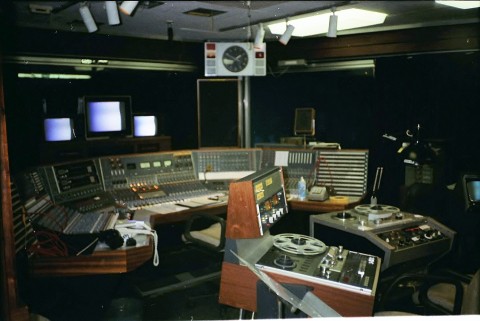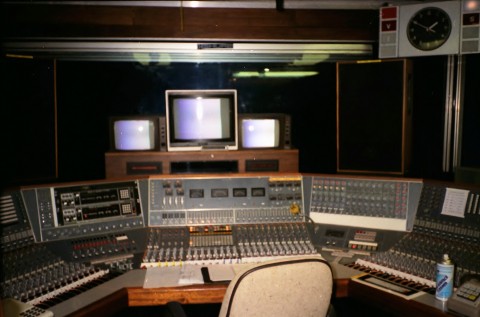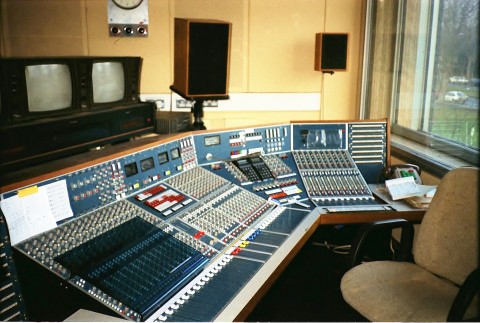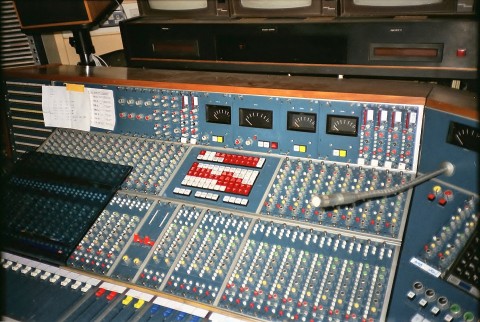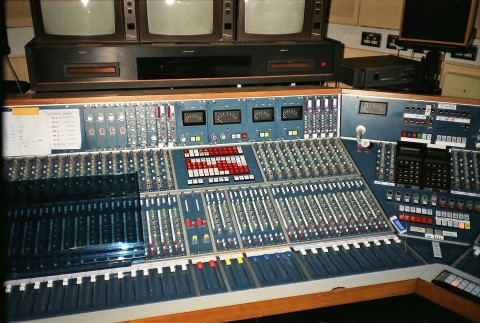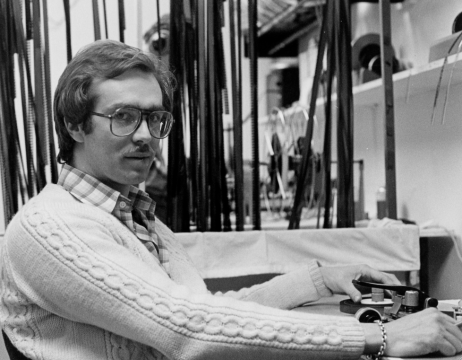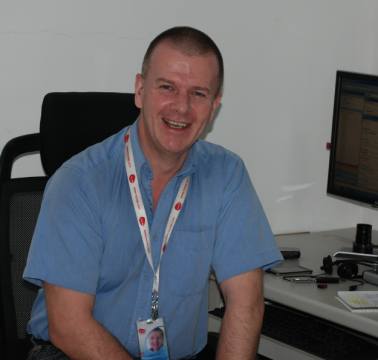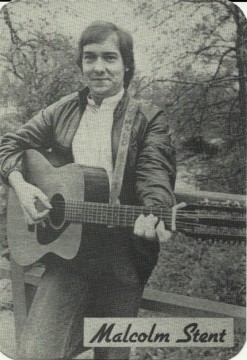Tag: Pebble Mill at One
Studio C, Calrec Sound Desk – Peter Poole
Photos by Peter Poole, no reproduction without permission.
Studio C was the Foyer, made famous by ‘Pebble Mill At One’. In the early days of ‘Pebble Mill At One’, Studio C did not have a dedicated Production Gallery. Studio A or B’s Galleries were used depending on which one was available. About 1982 Studio C had it’s own Gallery built. This enabled much greater use of the Foyer by other programmes. ‘Saturday Night At The Mill’ and ‘Good Morning With Anne And Nick’ were among many programmes to be broadcast from Studio C. In the final years of Pebble Mill the Foyer was used to record the daytime drama ‘Doctors’.
The photos show the Studio C, Calrec Sound Desk, which gave similar facilities to the Studio A desk, and offered more channels than the Studio B desk. It was very well designed for live broadcasting.
Peter Poole
Merrick Simmonds, Film Editor – photo by Peter Poole
Photo by Peter Poole, no reproduction without permission.
This photo shows Merrick editing in one of the film editing rooms. Before PSC (portable single camera) most location programmes were shot on film. Pebble Mill had several film editing rooms. Editors often worked late into the night to meet transmission times.
News was shot on reversal film and processed in Pebble Mill’s film processing unit. I think it took about an hour to process the film. Then it was edited and sometimes a voice over added. This made getting a story to air very slow.
Merrick latter became a director for Midlands Today. After that he directed ‘Pebble Mill At One’ and many other network programmes, including ‘Good Morning with Anne and Nick’.
Peter Poole
Philip Morgan’s blog
My first brush with the newly opened BBC Midlands HQ was when my school class were “extras” on the rides at a fairground set up in Cannon Hill Park as part of the 100th edition of the lunchtime Pebble Mill at One programme. It was the 1970’s and I was fascinated by the Outside Broadcast operation mounted just across the road from the gleaming new studio complex. From that day on my heart was set on a career in broadcasting.
When I left school I wrote in to the (then) BBC Radio Birmingham and was invited to go along to look around the station. I remember it well as my visit was on the very same day that the stunt artist famously jumped off the building onto a pile of cardboard boxes in the courtyard for Pebble Mill at One. The visit led to the chance to become a “helper” on the Saturday children’s programme “Radio Brum Club” which was broadcast at 10.00am on Saturday morning before the “Ross and Henry Show” with a repeat at the same time on Sunday. I helped by recording the ROT, editing insert tapes on Studer B62’s, driving the MKII Pye desk in the Studio 2 cubicle and also doing location interviews with a Uher tape machine. Before long I was doing all sorts of fun interviews and features – frequently nabbing guests from Pebble Mill at One or The Basil Brush Show (which was “hosted” in TV Studio A on Saturdays). I did interviews with a very young Lenny Henry at the old Bingley Hall and a ringside knockabout chat with the wrestler Jackie Pallo Jnr. After these items had been on Brum Club I popped them into an envelope and sent them on to the Radio One “Playground” programme (a networked magazine similar to “Brum Club”) which went out on Sunday mornings just before “Junior Choice” (and so ‘pre-inherited’ an audience of many millions of listeners). Sadly I heard nothing more and assumed that my cheeky submission of a little jiffy bag of 5″ tapes and cue sheets had been chucked into a recycling bin at Broadcasting House!
Some months later at a party I met a teacher friend in Birmingham who it turned out had been freelancing for “Playground”. Out of the blue she congratulated me for my interview items – which she revealed had actually been broadcast on “Playground”. She urged me to get in touch with the producer (Don George at BH) as he was trying to trace me so that he could pay my network fees and give me more work. When I got in touch with Don he very kindly invited me to visit the recording of “Playground” one week at Egton House and introduced me to the presenter David Rider. Don had links to BBC Midlands himself as he revealed himself to have been on attachment to the 282 Broad Street radio studios in the 1950’s and he had been one of the SM’s who helped to “kill” Grace Archer (with the SFX of a burning barn anyway!). He kindly arranged with Jock Gallagher (Network Editor Radio at Pebble Mill at that time) that I could join the other network freelance contributors on the fifth floor at Pebble Mill and make regular contributions to the show. This was certainly a very lucky break and led to the chance to offer interviews to “Playground” as well as other programmes such as “The John Dunn Show” on Radio 2.
Network radio was certainly a very different operation to its local counterpart. I couldn’t just wander into an empty studio and ‘self-op’ a feature. Instead I would have to book a studio through the bookings department and someone from the Audio Unit would be on hand to operate the area. One day I needed to record some links for a package that I had produced with the pop star David Soul. When I booked a studio I was surprised that the only area available was Studio 1 where the Midlands Radio Orchestra recorded. Of course I expected that I would record my links in the adjoining “narrator studio” adjacent to the cubicle. However when I turned up in the cubicle at 10.00am with my typewritten script to start the booking the sound supervisor claimed that he had no idea how to patch a mic from the studio into the Type “D” desk and then he indicated that I would have to do my links from “out there” – the 3,000 sq ft floor of the concert studio itself! The studio was completely empty except for a microphone and headphones laid out on a small square table in the centre of the floor and a set of acoustic screens which had been carefully set up on three sides of the table. As I sat alone at that microphone in that massive studio and cleared my throat for the recording I was terrified! I must admit that over the years I’ve come to the conclusion that this was all a jolly jape by the sound supervisor to give me a bit of a baptism by fire…
I used to spend as much time as I could in the radio studios, or helping to edit tapes in the office for other colleagues. My forays around the building included lots of time spent in the Studio “A” observation gallery and in edit suites. Pebble Mill was a marvellous centre in that everyone was friendly and people were always ready to share knowledge if you were keen to ask questions. I knew designers, journalists, film editors, directors, researchers, projectionists, sound supervisors, people from TAR, indeed from all over the building. Because Pebble Mill had all aspects of production under one roof it was a terrific place to learn the nuts and bolts of broadcasting. I soon became friends with people in the film transfer suites who would kindly help me out when they had downtime by letting me copy tapes or grab sound effects and that led to opportunities to do freelance shifts in transfer or the dubbing record room working in areas that very few people in the building knew much about – or even knew existed! It was a perfect combination with my radio work and I spent several years freelancing in both areas.
The Network Radio department always seemed to be thriving under Jock Gallagher and I remember several very happy Christmas lunches where after we had enjoyed lunch in the 7th floor canteen, Jock would lead all the radio folks behind the serving counter and we would serve Christmas lunch to all the catering staff (who obviously numbered many more than those we actually saw behind the servery each day).
Eventually I joined the BBC technical staff elsewhere in the BBC and did the BBC “A” course at Wood Norton. But I will always cherish my teen years spent at Pebble Mill and treasure the wonderful people from so many departments who took me under their wing and so generously shared their expertise and enthusiasm with me.
Pebble Mill in the 70’s was a bustling and innovative production centre and the building – and its equipment – was gleaming and state of the art and the staff shared a real sense of optimism where any creative idea seemed possible. I was therefore a little sad to return for the auction of contents (in November 2004) and to explore the building which by then was on the brink of final closure and looked completely forlorn. Its offices and technical areas were very shabby and of course almost completely devoid of all the wonderful and talented people that I was so used to seeing in the past and which brought the place to life. Nevertheless I decided to photograph as much as possible before the building was lost forever. Pebble Mill was a unique and happy working environment which produced so many fine and memorable programmes in its heyday. I was always proud to have the chance to work there with so many warm and wonderful people. It all seems like only yesterday…
Philip Morgan
Malcolm Stent – Radio WM Photocard
Copyright resides with the original holder, no reproduction without permission.
Malcolm presented on both Radio Birmingham and Radio WM, with ‘Folk Scene’ and ‘Malcolm Stent in the Barmaid’s Arms’. He was often accompanied by his guitar, and never relied on scripts or running orders! He was described on the BBC website as a ‘folk-singing humorist’.
Thanks to Stuart Gandy for making this Radio WM photocard available.
The following comments have been left by people who remember Malcolm’s show:
Lynn Cullimore: We were lucky enough to be able to pick up the Barmaid’s Arms from WM and do a TV version. I
did several series with Malcolm Stent. He is still working and often does things with the comedian Don Maclean who I have only recently met up with again, as I also worked with Don. John Clarke was the producer for Regional TV. Malc is great fun and a lovely person. I was the production assistant on barmaid’s arms for regional television and I loved it. The sets were fantastic – Mary Spencer was the designer and we had “customers” who had to have little tokens to get drinks as of course they were restricted! Malc and Rosie – yes her name was Mary Lloyd were brilliant. Oh happy days.
Andrew Langstone: Memories of ‘The Barmaid’s Arms’ with Malc and Rosie – those wonderful sound effects of a pub – clinking glasses and jolly background chatter. I think Rosie’s real name was Marie Lloyd [it was actually Mary Kendall]. The whole concept of a lunchtime in a pub with gentle banter and music ”from the juke box” was inspired – another of Mr Pickle’s ideas? It’s a pity BBC WM has such a different sound now – but that’s another story!
Tim Manning: The Barmaid’s Arms was a big success for Radio WM and for Malcolm, a daily chat show with its stereo pub sound effects in the background, and a cast of fictitious regulars (like Simon the Crisp Man). People used to turn up at Reception at the weekend asking for directions, and it’s one of very few local radio shows to have been turned into a regional opt-out TV series. All the music played was supposedly on the jukebox, although Rosie the barmaid did say she liked “those copulation albums”! Yes, it was very much a John Pickles concept. He once said to me that he thought of that WM schedule as being “a bit like a street”, starting the day over the breakfast table with news and the papers, followed by coffee with friends and neighbours (The 206 Team), popping into the pub at lunch time (Barmaid’s Arms), then a quiet time after that before picking up the kids from school, or coming home from work in the rush hour. One of his most inspired ideas was the “romance” between Stuart Roper and Viv Ellis, which was only ever really mentioned in other programmes, until the surreal and wonderful fake OB of the wedding on April Fool’s Day.
Pete Simpkin: Malc bless him is still at work in his favourite medium the stage and regularly writes produces and stars in the Solihull Arts Centre Annual Traditional family pantomime. I was honoured to help him with the technical side of his early days at Pebble mill where he presented Folk Club on Radio Birmingham. We also shared some stage talent shows which I produced at the Old Rep theatre and I produced his famous album ‘Malc Stent is not a working class Millionaire.’ After the tragic axing of the Barmaid’s he went onto be the ‘Warm up’ man for ‘PM at One’.
- « Previous Page
- 1
- …
- 33
- 34
- 35
- 36
- 37
- …
- 42
- Next Page »
